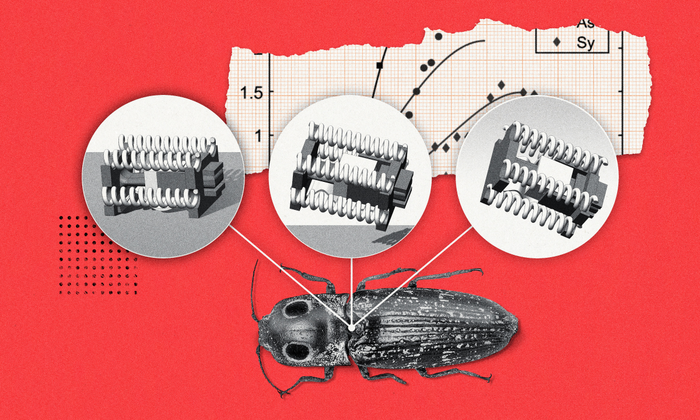
A team of researchers has made a significant leap forward in developing insect-sized jumping robots capable of performing tasks in the small spaces often found in mechanical, agricultural and search-and-rescue settings.
The international team, led by University of Illinois at Urbana-Champaign mechanical sciences and engineering professor Sameh Tawfick, has developed a series of click-beetle-sized robots small enough to fit into tight spaces, powerful enough to manoeuvre over obstacles and fast enough to match an insect’s rapid escape time.
Over the past decade, researchers at the University of Illinois and Princeton University have been studying the anatomy, mechanics and evolution of click beetles. In a 2020 study, they showed that snap buckling – the rapid release of elastic energy – of a coiled muscle within a click beetle’s thorax is triggered to allow them to propel themselves in the air many times their body length, as a means of righting themselves if flipped onto their backs.
‘One of the grand challenges of small-scale robotics is finding a design that is small, yet powerful enough to move around obstacles or quickly escape dangerous settings,’ Tawfick said.
In the new study, Tawfick and his team used tiny coiled actuators – analogous to animal muscles – that pull on a beam-shaped mechanism, causing it to slowly buckle and store elastic energy until it’s spontaneously released and amplified, propelling the robots upward.
‘This process, called a dynamic buckling cascade, is simple compared to the anatomy of a click beetle,’ Tawfick said. ‘However, simple is good in this case because it allows us to work and fabricate parts at this small scale.’
Guided by biological evolution and mathematical models, the team built and tested four device variations, landing on two configurations that can successfully jump without manual intervention. ‘Moving forward, we do not have a set approach on the exact design of the next generation of these robots, but this study plants a seed in the evolution of this technology – a process similar to biologic evolution,’ Tawfick said.
The team envisions the robots getting into tight spaces to help perform maintenance on large machines such as wind turbines and jet engines by taking pictures to identify problems.
‘We also imagine insect-scale robots being useful in modern agriculture,’ Tawfick said. ‘Scientists and farmers currently use drones and rovers to monitor crops, but sometimes researchers need a sensor to touch a plant or to capture a photograph of a very small-scale feature. Insect-scale robots can do that.’
The research has been published in the Proceedings of the National Academy of Sciences.
Image: graphic by Michael Vincent



